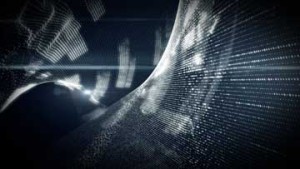
The initial conversations with Gibney focused on two integral aspects of the story: the first being the chat logs between Private Bradley Manning and computer hacker Adrian Lamo, and the second a visual representation of the World Wide Web and all the articles, tweets and products that help tell the story.
Framestore was also approached to create the main title sequence, which senior design director, Marc Smith accepted. From the first concept presentation, director Gibney and the team were particularly drawn to examples provided using particle systems within After Effects and C4D.
The intention was to create a technique by which footage and images could be broken apart and drawn together over time. They wanted to do this within a dynamic 3D space, sometimes abstract and often only legible from certain angles of view. This concept, along with the design and animation of the main title sequence, would serve as a springboard for many of the project’s sequences.
“This execution served the narrative of the film well – bringing clarity to images and events by compiling a multitude of elements and evidence,” Smith explained. “The creative also focused on the need for this network-inspired world to contain a sinister edge in keeping with the film’s content. To this end, the color palette was kept dark and minimal throughout, and the camera work would at times suddenly lurch or dive. What would start as a seemingly random set of pixels, would organically shift, twitch and grow to reveal an interconnected whole.”
Designing the chat logs for the film began as a collaboration between creative director, Murray Butler, and senior designer, Maryanne Butler. “The chats needed to feel textural and alive, sinister and at times, lonely,” Butler said. “So much of what the logs expressed was a personal outpouring from Private Manning so we had to stay sensitive to the subject in visualizing these. The logs went through many different designs, which included techniques of filming from plasma screens and re-importing it into Flame to give them a live quality as well as a texture that was not crisp and sharp.”
Visualizing data streams being exfiltrated began with concepts from artist Zack Lydon, which were then brought to life by Gabriel Pulecio using a combination of After Effects and C4D. The vast quantity of war logs that would eventually surface publicly were designed and animated by concept artist Callum McKeveny.
Another massive element of the project was recreating the numerous headlines that tracked the story of WikiLeaks and Assange. Gibney was keen to have these articles live in the web. Using initial trap-code tests and designs by Smith, AE artists Joe Lawrence and Byunghoon Han choreographed and rendered the final shots.
Additional effects created for the project ranged from compositing crash-zooms, to Twitter dramatizations, video effects and creative graphic representations of important documents, which were realized across several work platforms including After Effects, Flame and Cinema 4D.





